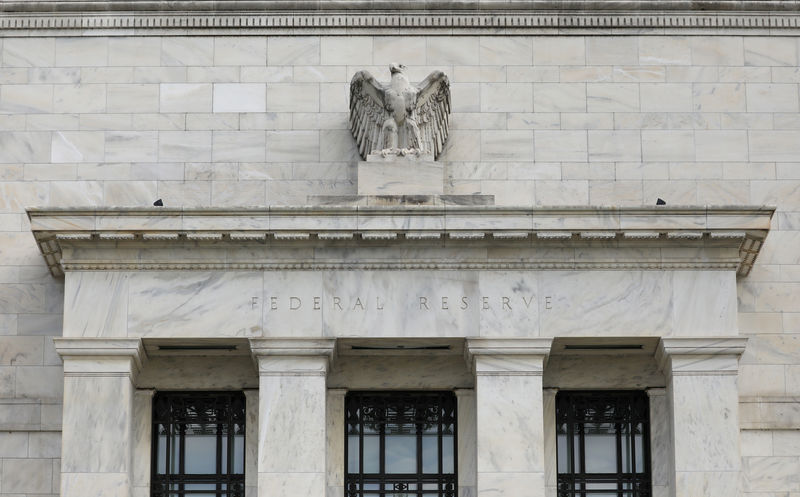 © Reuters. FILE PHOTO: The Federal Reserve building is pictured in Washington, DC
© Reuters. FILE PHOTO: The Federal Reserve building is pictured in Washington, DCBy Howard Schneider
WASHINGTON (Reuters) – Richard Clarida, U.S. President Donald Trump’s most recent addition to the Federal Reserve Board, made his debut speech on Thursday just days after Trump again slammed the Fed for raising interest rates. His message: rates should continue higher.
“If the data come in as I expect, I believe that some further gradual adjustment in the federal funds rate will be appropriate,” Fed Vice Chair Clarida said on Thursday, speaking in public for the first time in his new role.
The speech highlighted the gap between Trump’s biting rhetoric and the reality of a Fed board committed to long-standing plans to bring rates from record, crisis-era lows to levels more fitting for a healthy economy.
Trump has had a wide berth to reshape the central bank, with five of the Fed’s seven board seats open for him to fill, including the influential chairmanship that sets the tone for policy debates.
Yet at the urging of advisers like Treasury Secretary Steven Mnuchin and others sensitive to the importance of maintaining market faith in the Fed’s independence, he has picked a collection of comparatively mainstream economists and centrist Republicans.
As a group they have shown no sign of changing the course set by former chair Janet Yellen to guide an economy evolving largely as the Fed anticipated prior to Trump’s November 2016 election.
If anything, some of the tax, spending and trade policies Trump has pursued have made higher interest rates more justified. Tax cuts and extra spending spurred growth beyond what the Fed had earlier expected, while tariffs on important industrial products such as steel raised the risk of an inflation surprise.
STILL LOW
Fed policymakers broadly agree that the current steady pace of rate increases is warranted not as part of an effort to slow things down, but to trim the last of the stimulus deployed during a recession nearly 10 years ago. Even after the rate increases begun under Yellen in late 2015, the Fed’s policy rate is less than half of what it averaged between 1990 through 2007 when the last recession started, and remains low enough to still be supporting the economy, not restraining it.
(Graphic: Trump’s war of words on the Fed – https://tmsnrt.rs/2PlZ6jb)
Clarida, confirmed by the Senate in August after Trump’s first round of criticism of Fed rate increases, is merely the latest to join the club.
His recent writings, as an economist with Pimco and an established monetary theoretician, have been consistent with the core Fed view that it was time to “normalize” rates by moving them from loose toward “neutral.”
A 2015 essay hinted that going beyond neutral would be a “mistake,” suggesting he may favor an earlier end to rate increases than colleagues, including Powell, who foresee moving to a slightly “restrictive” level. His first outing as vice chair, though, put him squarely inside the Powell consensus.
The recent September rate increase, which Trump called crazy, was merely “another step in removing the extraordinary degree of accommodation put in place in the aftermath of the Global Financial Crisis,” Clarida said.
He said political pressure, “will in no way be a consideration” in policy-making.
If Trump’s other current Fed board nominees are approved, the consensus will likely only strengthen.
They include financial stability expert Nellie Liang, recently retired after a career as a Fed staffer; economist Marvin Goodfriend whose past writings suggest he would favor higher interest rates as a hedge against inflation; and Kansas community banker Michelle Bowman, unlikely to influence the policy debate in a seat designated to guard the interests of small financial institutions.
To change the dynamic he’d have to either renege on the pending appointments or let them lapse when a new Congress takes office in January, or boot his handpicked chairman, Jerome Powell, at the start of a second term. Under the laws governing independent bodies such as the Fed, he would be hard-pressed to remove a Fed board member “for cause,” language courts have ruled exclude policy disagreements.
But pressure may be mounting, as Nov. 6 midterm elections loom with a 2020 presidential race to follow. The stock markets that Trump has taken credit for lifting to new highs have sold off in recent days as investors adjusted to heightened trade risks, a dimming global growth outlook and a rise in long-term U.S. Treasury bond yields that has given investors higher returns on a safe alternative to equities.
Some Trump partisans, including former campaign manager Corey Lewandowski, have taken note, saying Trump’s pending Fed appointments should be swapped for nominees promising low rates.
But it is not certain that would matter.
Powell, as chair the most formative voice on policy, has been careful to build his own constituency. Familiar on Capitol Hill from years in Republican circles and policy advocacy, he has been a steady presence in congressional offices during his first months as Fed chair, and ranking Republicans have backed him when Trump has criticized the Fed’s work.
Source: Investing.com





























